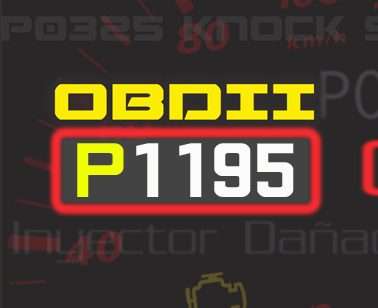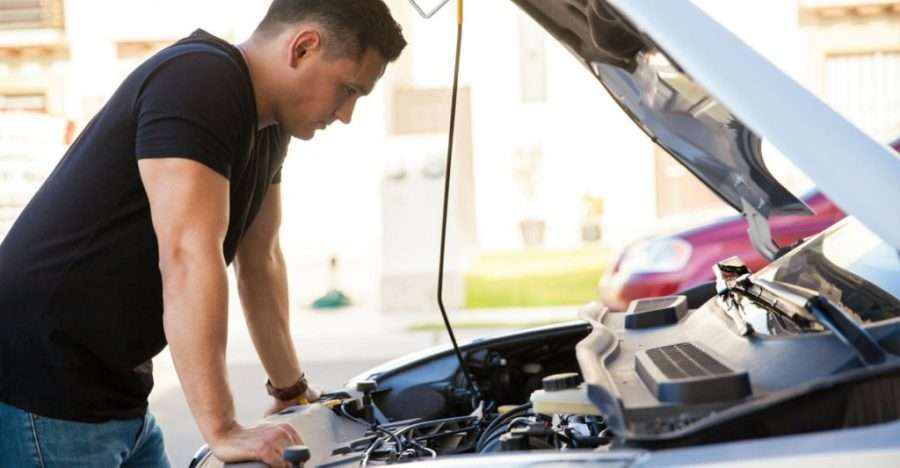
P1195 (Volkswagen, Audi, Skoda, Seat) Fuel pressure control valve - open circuit/short to ground
Content
P1195 – OBD-II Trouble Code Technical Description
Trouble code P1195 indicates an open circuit/short to ground in the fuel pressure regulator valve circuit in Volkswagen, Audi, Skoda, Seat vehicles.
What does the fault code mean P1195?
Trouble code P1195 indicates a problem in the fuel pressure regulator valve circuit. This valve plays an important role in regulating the fuel pressure entering the engine injection system. When P1195 appears, it means that there is an open circuit in the valve or a short circuit to ground. Improper functioning of the fuel pressure regulator valve can lead to unstable engine operation, loss of power, increased fuel consumption and other negative consequences.

Possible reasons
Some of the possible causes of the P1195 trouble code are:
- Broken wire: The wire connecting the fuel pressure regulator valve to the vehicle's electrical system may be broken due to mechanical damage or abrasion.
- Damage to connections: Damaged or corroded connections or connectors between the fuel pressure regulator valve and the electrical wiring can cause poor contact or an open circuit.
- Fuel pressure regulator valve malfunction: The fuel pressure regulator valve itself may be faulty due to wear, mechanical damage or other reasons, resulting in improper operation and possible open circuits.
- Short circuit to ground: Improper wiring insulation or corrosion can cause the fuel pressure regulator valve wiring to short to ground.
- Malfunctions in the engine control module (ECU): Problems with the engine control module can cause the fuel pressure regulator valve to not operate properly or read its signals incorrectly, which can result in a P1195 code.
- Mechanical damage or defects: Mechanical damage within the fuel system or other defects can cause the fuel pressure regulator valve to not operate properly, resulting in the P1195 code.
What are the symptoms of a fault code? P1195?
Symptoms for DTC P1195 may include the following:
- Activation of the “Check Engine” indicator: Trouble code P1195 usually causes the Check Engine light to turn on on your dashboard. This is the first sign of a problem and indicates that the vehicle needs to be diagnosed.
- Unstable engine operation: Incorrect fuel pressure caused by a faulty fuel pressure regulator valve may cause the engine to run rough. This can manifest itself as a shaky idle, erratic revs, or even an engine that refuses to start.
- Loss of power: Incorrect fuel pressure can also cause loss of engine power. The vehicle may respond less effectively to the accelerator pedal, especially when accelerating or climbing.
- Increased fuel consumption: A malfunctioning fuel pressure regulator valve can result in inefficient fuel combustion, which can increase the vehicle's fuel consumption.
- Unusual sounds or vibrations: Incorrect fuel pressure may cause unusual sounds or vibrations when the engine is running. This may manifest itself in the form of knocking, unusual noises or vibrations that can be felt inside the car.
- Problems with launching: A malfunctioning fuel pressure regulator valve can make the engine difficult to start, especially in cold weather or after a long period of inactivity.
If you notice any of these symptoms, especially when your Check Engine Light is activated, it is recommended that you contact a qualified auto mechanic to diagnose and repair the problem.
How to diagnose a fault code P1195?
To diagnose DTC P1195, follow these steps:
- Checking the error code: First use a diagnostic scan tool to read the P1195 fault code from the engine control module (ECU) memory. This will give you information about what caused this error to appear.
- Visual inspection: Inspect the wiring and connections associated with the fuel pressure regulator valve. Check for damage, corrosion or broken wires, as well as the condition of the connectors.
- Checking the fuel pressure regulator valve: Use a multimeter to check the resistance at the fuel pressure regulator valve terminals. The resistance must be within the permissible value specified in the manufacturer's technical documentation.
- Checking the supply voltage: Measure the supply voltage at the fuel pressure regulator valve terminals using a multimeter. Make sure the voltage is within the required range.
- Grounding check: Check for ground at the corresponding terminal of the fuel pressure regulator valve. A missing ground or an incorrect ground may be the cause of P1195.
- Additional tests: Depending on the results of the above steps, additional tests may be required, such as checking the fuel pressure in the system, checking the control signal from the ECU, and others.
- Checking the Engine Control Module (ECU): If necessary, perform diagnostics on the engine control module to check its functionality and update its software.
- Using diagnostic equipment: In some cases, specialized diagnostic equipment may be required to diagnose the vehicle's electrical systems in more detail.
After diagnosing and identifying the cause of error P1195, you can begin repair measures to correct the problem.
Diagnostic errors
When diagnosing DTC P1195, the following errors may occur:
- Misinterpretation of data: Incorrect reading or interpretation of data from a diagnostic scanner or multimeter may lead to incorrect conclusions about the cause of the error. For example, misreading a multimeter reading when testing resistance or voltage can lead to a misdiagnosis.
- Skip the entire system check: Failure to sufficiently check all components and parameters associated with the fuel pressure regulator valve may result in other potential problems being missed. For example, not checking the condition of the wiring or not taking into account other possible malfunctions in the fuel supply system.
- Insufficient expertise or experience: Lack of sufficient experience or knowledge in the field of diagnosing automotive systems may lead to incorrect conclusions or incorrect selection of further actions in the diagnostic process.
- Faulty hardware: Using faulty or incompatible diagnostic equipment can also lead to diagnostic errors. For example, incompatibility of the scanner with a certain car model may make it impossible to obtain reliable data.
- Skipping Additional Tests: Some problems may not be detected without additional tests or diagnostic procedures. Skipping such tests may result in missing important information about the health of the system.
It is important to carry out diagnostics carefully, taking into account possible errors, and, if necessary, seek help from an experienced auto mechanic or specialist.
How serious is the fault code? P1195?
Trouble code P1195 is serious because it indicates a problem with the fuel pressure regulator valve or its electrical circuit. This valve plays an important role in maintaining the correct fuel pressure in the injection system, which affects engine efficiency.
Incorrect fuel pressure can cause engine roughness, loss of power, increased fuel consumption and other serious problems. In the long term, this can also lead to damage to other components of the fuel injection system and even serious engine damage.
In addition, the activation of the Check Engine light indicates that the vehicle does not meet environmental safety standards, which may result in a refusal to pass a technical inspection or fines in accordance with local laws.
Therefore, DTC P1195 requires immediate attention and repair to prevent possible negative consequences on engine performance and vehicle operational safety.
What repair will help eliminate the code? P1195?
Resolving the P1195 trouble code requires performing a series of diagnostic procedures to determine the exact cause of the problem. Once the cause of the problem has been determined, appropriate repairs can begin. Here are some possible actions that may help resolve the P1195 code:
- Replacing the fuel pressure regulator valve: If it is found that the fuel pressure regulator valve itself is faulty or damaged, it should be replaced with a new original or high-quality replacement.
- Repair or replacement of electrical wiring: Check the electrical wiring, connections and connectors associated with the fuel pressure regulator valve. In case of breaks, damage or corrosion of wires, they must be repaired or replaced.
- Checking and replacing fuses and relays: Check the fuses and relays that supply and control the fuel pressure regulator valve. Replace damaged or blown fuses and relays.
- Diagnostics and repair of the engine control module (ECU): If the problem with the fuel pressure regulator valve is due to a faulty engine control module, the ECU must be diagnosed and, if necessary, repaired or replaced.
- Updating the software: In some cases, the cause of the P1195 code may be incompatibility or outdated engine control module software. Update the ECU software to the latest version if possible.
- Additional diagnostics and repairs: If necessary, perform additional diagnostics and repairs on other fuel and engine management system components, such as fuel pressure sensors, oxygen sensors, and others.
It is important to eliminate the cause of the malfunction, and not just reset the error code. If you do not have the experience or necessary equipment to diagnose and repair your vehicle, it is recommended that you contact a qualified auto mechanic or auto repair shop.

